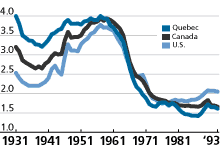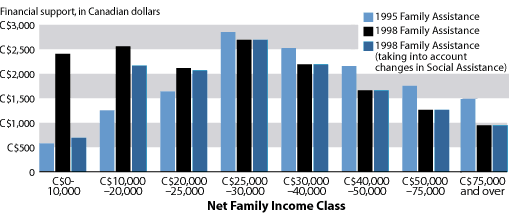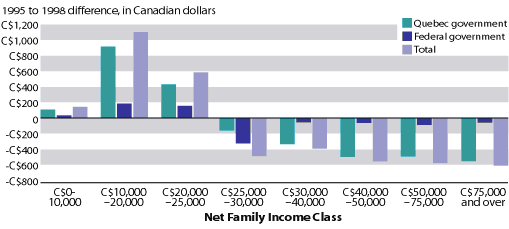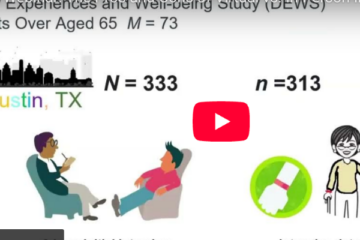
Quebec's Alternative to Pronatalism
(December 2001) For centuries, fertility was seen as central to the survival of Quebec’s distinct French-Canadian culture. The province’s political elite and its clergy successfully promoted relatively high fertility rates to overcome subordination to English-Canada. As the figure below shows, however, between 1961 and 1971, Quebec’s fertility rate plummeted. Since then, two kinds of government intervention to make parenthood more attractive have been tried, but experience has shown that pronatalism is no longer the means to ensure a (distinctive) francophone Quebec.
Total Fertility Rates for Quebec, Canada, and the United States, 1931-1993

Sources: Statistics Canada and the U.S. National Center for Health Statistics.
In a population engineering effort unprecedented in North America, the Quebec government in 1988 implemented three programs to boost fertility: allowances for newborns that, after amendments, paid women C$500 for a first birth, C$1,000 for a second, and C$8,000 for a third and each subsequent birth (one Canadian dollar equals 63 U.S. cents); a family allowance for all children under 18 years; and an additional allowance for children under age 6.
Moreover, with the birth of a third or subsequent child, parents received 27 weeks of paid leave, plus 15 weeks of federal maternity benefits. Families with two or more children under age 18 qualified for a C$7,000 interest-free loan to help purchase a first home. Overall, Quebec families received almost C$4 billion annually in direct and income tax assistance from the provincial and federal governments.
Reactions to these forms of direct financial assistance varied. Noninterventionists argued that fertility decisions were individual, not governmental, responsibilities. Some even charged that the pronatalists had invented a fertility crisis to advance the nationalist agenda. One scathing critique by feminist professor Heather Maroney of the University of Carleton charged that Quebec’s pronatal policies marginalized women, reducing them to objects of demographic policy.
Social interventionists supported government action, not through pronatalist intervention, but through social policies to improve female equity and assist families. Of particular importance were policies to decrease tensions between employment and family responsibilities.
These critiques coincided with a growing awareness that Quebec’s incentive policies were not producing the expected birth increases. Although there was an initial increase in the late 1980s in the total fertility rate from 1.49 children per woman in 1988 to 1.72 in 1990, after 1990 total births decreased, and families with three or more children remained uncommon. Overall, policies favoring third and subsequent children were viewed increasingly as contrary to the needs of most families.
In 1997 Quebec switched its approach to strengthening families. It created the Ministry of Family and Children’s Services and gave it a budget of C$500 million. The Ministry was to:
- Establish a standard child allowance program for low-income families, wherein the amount of allowances would depend on the number of dependent children under age 18, on family type (single-parent, two-parent), and on income (a threshold of C$15,332 for single-parent families; C$21,825 for two-parent families).
- Offer a maternity/parental leave plan that would pay more during and after pregnancy.
- Provide a network of government-regulated, highly subsidized (C$5 per day) day-care facilities offering a quality educational program to children from birth to kindergarten age. (Presently, Quebec is the only province to have universal subsidized day care. Ten innovative pilot projects have also recently been launched that offer evening and 24-hour day-care service, seven days a week.)
But even the new family assistance policies have shortcomings. A recent study indicates that 72 percent of Quebec families are worse off under the new family assistance program than under the earlier pronatal one, despite government promises that 95 percent of families would benefit from the new policies.
While the previous pronatal program provided universal assistance, the new initiatives provide targeted assistance aimed almost exclusively at low-income working families (those with a net income between C$10,000 and C$25,000). Families with a net income of less than C$10,000 benefit only marginally, since their increase in family assistance is offset by a reduction of a similar amount in social assistance. (Canada offers both family assistance, supporting the needs of children and adults within families, and social assistance, which spans health, employment, and general social welfare.) Families with a net income of C$25,000 or higher now receive less family assistance; the money once spent on them is now allocated to low-income working families. And due to budget constraints, the parental leave plan has yet to be realized.
In terms of the universal C$5-a-day day-care program, there are not enough regulated day-care spaces to keep up with demand. Consequently, Quebec day-care centers now have long waiting lists and one of the highest ratios of children to day-care workers in Canada.
Although the new policies promote work, they inadvertently limit women’s choices by offering more assistance to families with employed mothers than to families with stay-at-home mothers (through universal C$5-a-day day care and through cutbacks in social assistance).
Clearly, promoting higher fertility has not been effective for the past half-century. Like many other modern societies, Quebec faces a low birth rate and an aging population. The Quebec government cannot convince women to bear more children than they desire. The Quebec government has found and will continue to find other means to protect the distinctiveness of its society, including reassessing family assistance programs.
Catherine Krull is a professor of sociology at Queens University in Kingston, Ontario.
WebExtra
Author’s References
Baker, Maureen. 1994. “Family and Population Policy in Québec: Implications for Women.” Canadian Journal of Women and the Law/ Revue Femmes et Droit 7:116-132.
Baker, Maureen. 1990. “Family Policy in Quebec.” Background Paper. Ottawa: Library of Parliament, Research Branch.
Baril, Robert, Pierre Lefebvre, and Philip Merrigan. 2000. “Quebec Family Policy: Impact and Options.” IRPP 6(1): 4-52.
Caldwell, Gary and Daniel Fournier. 1987. “The Quebec Question: A Matter of Population.” The Canadian Journal of Sociology 12:16-41.
Clark, Campbell. “Family Ministry Draws Fire.” The Montreal Gazette, May 14, 1997: A9.
Council on French Life in America. 1971. “The Fertility Crises in Quebec.” Translated by Katya von Knorring. In Carl F. Grindstaff, Craig L. Boydell and Paul C. Whitehead (eds.) Population Issues in Canada.
Hamilton, Roberta. 1995. “Pro-natalism, Feminism, and Nationalism.” In Francois-Pierre Gingras (ed.) Gender and Politics in Contemporary Canada, Toronto: Oxford University Press, 135-152.
Henripin, Jacques and Evelyne Lapierre-Adamcyk. 1974. La fin de la revanche des berceaux. Montreal: PUM.
Henripin, Jacques. 1971. “De la fécondité naturelle à le prévention des naissances: l’évolution démographique au Canada francais depuis le XVIII siècle,” in M. Rioux and Y. Martin (eds.) La Société Canadienne francaise. Montreal: Hurtubise, pp. 215-226.
King, Leslie. 1998. “France Needs Children: Pronatalism, Nationalism and Women’s Equity.” The Sociological Quarterly 39(1): 33-52.
Lavigne, Marie. 1986. “Feminist Reflections on the Fertility of Women in Québec.” In Roberta Hamilton and Michèle Barrett (Eds.) The Politics of Diversity: Feminism, Marxism and Nationalism. London: Verso: 303-321.
Maroney, Heather J. 1992. “Who Has the Baby? Nationalism, Pronatalism and the Construction of a ‘Demographic Crisis’ in Quebec, 1960-1988.” Studies in Political Economy 39:7-36.
Mathews, G. 1984. Le choc démographique: le déclin du Québec est-il inévitable. Montréal: Boréal Express.
Regie des rentes du Québec, 1994. Les allocations d’aide aux familles: Statistiques 1994 [Allocations of assistance to families: 1994 statistics]. Quebec Pension Board.
Saint-Pierre, Marie Hélène et Renée B.-Dandurand. 2000. Axes et Enjeux de la Politique Familiale Québécoise: Présentation d’Une Recension Informatisée des Écrits. Montréal, Québec: INRS – Culture et Société.
Statistics Canada. 1993. Selected Birth and Fertility Statistics, Canada, 1921-1990. Ottawa: Minister of Industry, Trade and Technology (Cat. No. 82-553).
Wennemo, Irene. 1992. “The Development of Family Policy: A Comparison of Family Benefits and Tax Reductions for Families in 18 OECD Countries.” Acta Sociologica 35: 201-217.
Figure 1
Financial Impact of Provincial Family Assistance Reforms in Quebec, by Net Family Income Class

Source: R. Baril, P. Lefebvre, and P. Merrigan, “Quebec Family Policy: Impact and Options” (2000) IRPP 6(1): 16.
Figure 2
1998 to 1995 Monetary Difference in Provincial, Federal, and Total Financial Assistance Progams in Quebec, by Net Family Income Class

Source: R. Baril, P. Lefebvre, and P. Merrigan, “Quebec Family Policy: Impact and Options” (2000) IRPP.






